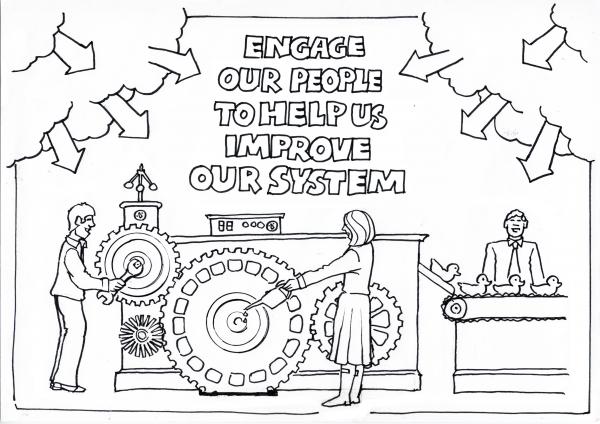Tools to make you THINK differently about your business
Have you ever thought about how many times you have heard leaders say that “People are our most precious resource”?
How many times do you really believe them?
Undoubtedly, people should be the most precious resource, along with time: people, because people are the only source of creativity, innovation and improvement, and time, because it cannot be stored; each moment is a one off which will never recur.
So how do we manage people? As hinted previously, traditional management tends to be “controlling”. The belief system, and consequently motivation, starts with the thinking “how can we make the workforce follow our instructions and our orders”?
We would suggest a different starting point and a different belief system:
- People work best when the systems (the processes defined in the Book of Best Practice) have been designed with them to help them execute their tasks more easily
- We are all different (thankfully): we have different experiences and values (all of which are valuable); we learn differently and we go about our work in different ways
- An organisation can only learn if its people learn
- If you need instructions, procedures and/or standing orders detailing how the work works, it is best to involve your staff in their creation

If we want to truly understand people and for them to help us improve the system, we need, above anything else, to understand how they learn. There are only five ways into the brain and each is through one of the five senses. In management, however, we tend not to sniff or taste our way to success. The three dominant senses for learning are therefore:
- Through verbal explanations – auditory
- Through demonstration or active involvement – kinaesthetic
- Through graphic portrayals, words in reports, pictures, videos etc of the subjects – visual
We use all of these senses. However, many of us will have a dominant sense and therefore a dominant preference for the way in which we learn. It is actually very easy to elicit the preferred learning style from someone by asking them to describe something, anything, they recently learnt.
So, for instance, adapting the work of Peter R. Scholtes, questions may be asked as follows:
Q What have you learnt recently?
A Well, I learnt how to change the oil filter on my car
Q How did you learn that?
A I learnt it from my neighbour
Q What did your neighbour do that helped you learn how to do that?
- A (Visual person) I watched him do it on his car then he watched me change the filter on mine
- A (Kinaesthetic person) I had him guide me through the process of putting the filter on
- A (Auditory person) He first explained what oil filters are for and then he told me how to do the job
It means we have to listen very carefully as the words people use will tend to reflect their learning style. But, how many of us are even aware that this information can be gleaned so easily let alone use it?
There is a whole science applied to this which goes by the user friendly name of Neuro Linguistic Programming or NLP for short. It’s a fantastic subject and a lot of work has been done around motivation profiles by a lady called Shelle Rose Charvet.
The point is, how much more could we learn…and teach, if we targeted the preferred learning and motivational styles of the people we manage? How often do we judge others as poor workers and students when we may not have bothered to learn how they learn or are motivated?
The traditional belief system starts from the premise that people need to be controlled and that systems and incentives are based around this premise. Management by objectives, performance appraisal and (often short-term) financial incentives for doing a “good job” are indicative of these systems.
An interesting thought experiment would be to consider what the most important issues are to the modern leader. I would suggest that, were you to ask them, not one would say “I personally need better goals, objectives and performance standards” or “I personally need better performance appraisal”.
These tools are based on the idea that “I’m okay, but others in the organisation are not”. It is my belief that this is a worrying premise.
Conclusion
To properly engage people you need to:
- Have articulated the company’s purpose
- Have involved staff with creating your book of best practice that helps them to do their job better
- Understand their learning styles so they can help you improve the way in which your work works
Having now studied the thinking behind “Engage the People” in the next blog, which will be early in the New Year, we’ll explore how this has been applied in practice.
Related tools and ideas
- Purpose
- The Core Activity Map
Recommended references
- NLP The New Technology of Achievement by Steve Andreas and Charles Faulkner – great book, excellent read
- Words that Change Minds Shelle Rose Charvet
- Dragon Slaying: a better way to manage by Mark Woods; email mwoods@statius.co.uk to receive your free copy
- Fourth Generation Management. Brian Joiner
Downloadable resources
To find out how Statius can help you deliver:
• Better strategies
• Better systems
• Better measurement and
• Engaged people delivering
• Better results
Call us now on 0208 460 3345 or email sales@statius.co.uk


Comments are closed